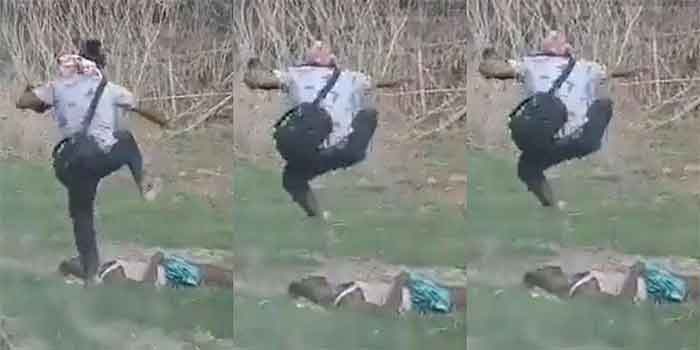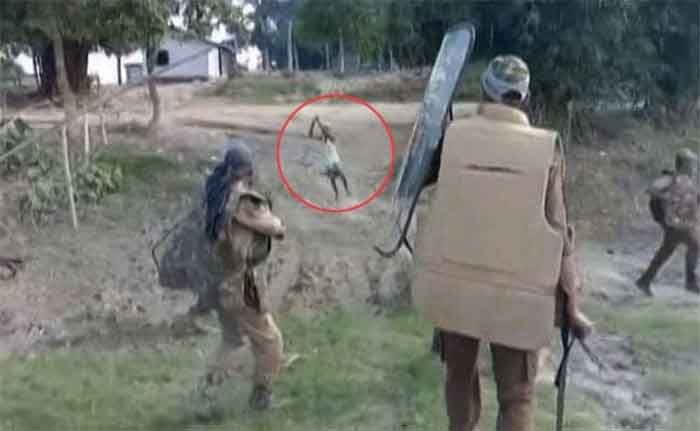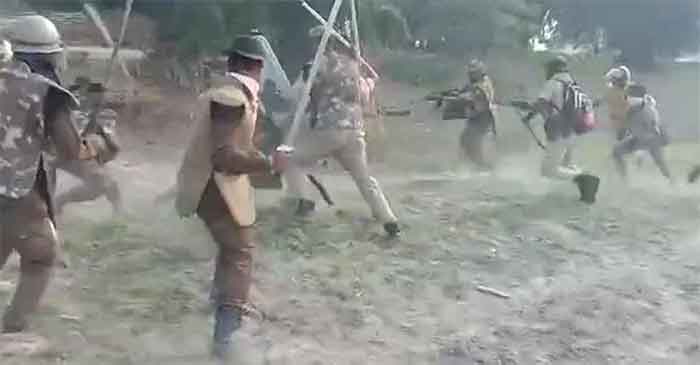
We are shaken and frozen. Is this the last sky? We can hardly gather words to write this. Assembling them to describe the heinousness of the crime we saw is both painful and difficult. On Thursday, a body, a Muslim body was not only gunned down in cold blood from a close range, but a government photographer, masked his face with Asomiya gamocha, decided to humiliate by jumping, kicking, and boxing that body in his last minutes and perhaps even when he had passed. Policemen, too, joined the photographer in humiliating the dying body. After displaying such necrophilia, the photographer was hugged by some of the policemen present in the scene. Isn’t this collective political necrophilia?
This singular event is a disturbing testimony to the quality of hate harboured deep in the minds of people in Assam. The victim in Darrang was visibly someone whose hearth and home was being uprooted days ago. Imagine how satisfying it must be for a necrophiliac nationalists to first evict someone, make them live by the river, in the cold like animals stranded in an isolated land at night and then watch them getting killed and in the moments of their certain death, injure them with kicks and punches and continue to do so even after the victim has passed. It is not just death and the performed necrophilia but also the preceding condition of the person under which they suffered this victimhood. How has such hate become possible? Who benefits from such hatred? Do ask yourself.
The only relatable image that comes to our mind is what happened in Thammasat University in 1976. On that day, the military, police and right-wing paramilitary forces surrounded the university. After ensuring that thousands of students were under siege, the forces assaulted them with M-16s, recoilless rifles and grenades for hours. Official casualties were 46, but survivor accounts said that close to 100 had died. Vigilantes supported the official forces in shooting, assaulting, raping and murdering unarmed students. One image was caught, and it was haunting. A dead student was hung from a tree, and his dead body was beaten with a chair.
The event of Darrang today carried that same kind of necrophilia, the same kind of hatred and disgust for the other—that won’t stop at someone’s death. What happened today is also not a singular event or expression. It is very much embedded in our society and culture. Thus this event is not an exception or madness of a singular individual but is a contagion that is communicated (contagion as communication) among a large number of Assamese nationalists who harbour such desires of harm and assault.
The government in Assam is selectively evicting the Muslims. The government is making hundreds of these families homeless and we hardly witness any protest. The vernacular media is completely functioning in collaboration with the government, and critical voices in the state are few. The people evicted are already termed as encroachers by the national and local media alike. Where do we go from here?
Today’s barbaric incident has shaken thousands of people in Assam, especially the Muslims of the state. Media do not carry their voice, and as a consequence they are using social media to express their hopelessness and fear. Muslims in Assam are helpless today. Nazimuddin dreamt yesterday. He saw that evictions had come to a halt, and forces were retreating. Such was the force of the violence that the unconscious mind is cultivating a politics of hope in a milieu filled with fear. Time has come, where people’s dreams will also be scrutinized. We must also write about our dreams before they are red-flagged.
Our paragraphs are disjointed and shaky because we are too. What happened yesterday is not an exception to culture, but it comes out of the bosom of Assamese nationalism and the culture it has inherited. The psychological and metaphysical defence required to prevent the individual from descending to such barbarity is lost. This absence is also present in our culture. This happens when the self is defined too rigidly in terms of the not-self, as Ashis Nandy reminded us. Can the Assamese think of themselves without thinking of the “Bangladeshi”?
Many people have commented on the barbarity of the army/cops/police (do we really know who they are?) and pitted it against the photographer Bijoy Bania. Both are barbarous, and killing has become normalized, but it is disturbing the humiliations of the dead body and celebration after that. It must disturb you. If the former represents the state, the latter represents culture. This marriage where they celebrate death and dance around the carcass should trouble you. It should make you question the culture and language we so intimately hold on to and defend. Yesterday was a realization of culture, a part of the program of Assamese nationalism. Yesterday was not a revelation but a repetition of the past. The question is, how do we (more so the minorities) live from here on?
The words of Vilem Flusser aptly arrests yesterday’s event:
“the distance that separates us from the event does not mitigate the abyss, it erodes it even deeper. Because the distance progressively dissolves the aura of the horror that envelops the event, and it progressively opens up a vision of scene…it is the ultimate reification of people into amorphous objects, into ashes.”
Although written in the context of Auschwitz, these sentiments echo the skies of Assam, as the minority was objectively killed yesterday, again. They have already died before. Yesterday was not a deviation or violation from what “being an Assamese” in contemporary Assam means. It was precisely a result of the application of that identity and culture. Will you still believe in culture and language or dance in the Assamese rain? What do you think the minority wait for? Mutilation? Death? Humiliation?
Yesterday was only a variation of Assamese nationalism. Language riots, Nellie, IMDT, NRC. They are all variations, not deviations. Everything operates within that apparatus of Assamese nationalism. There is no exit; we are forever consumed by the apparatus of culture, the post-history of our “beloved” nationalism.
Suraj is a researcher from Assam











































